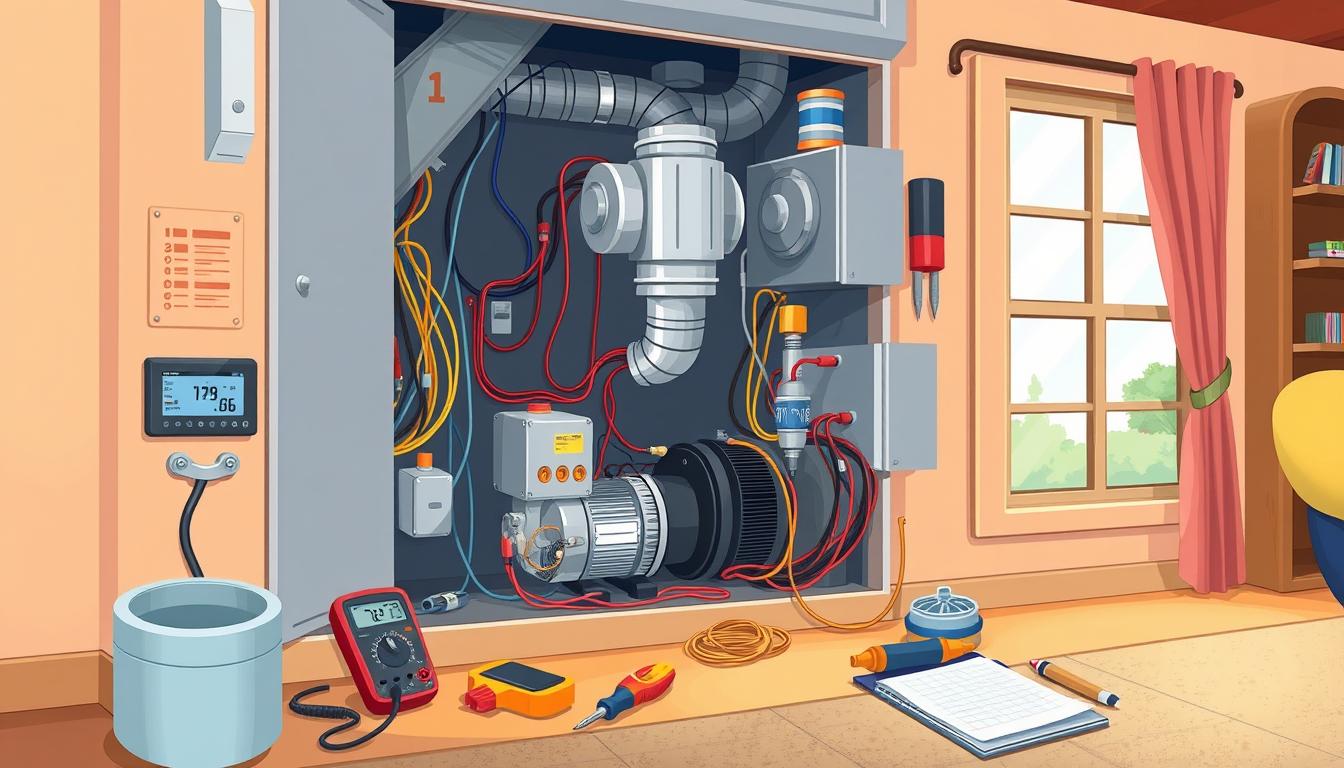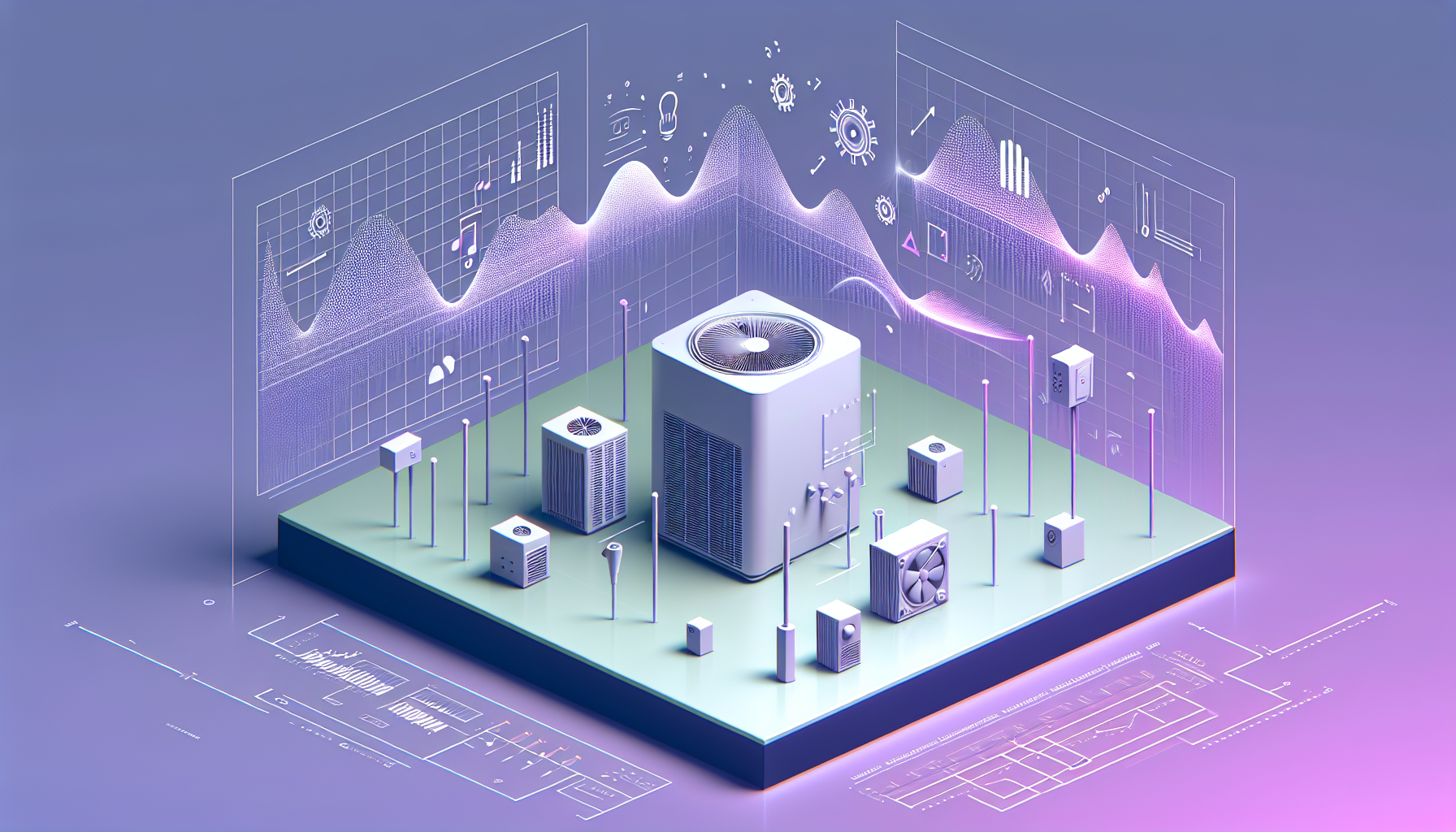As a homeowner in East Texas, you know how crucial a working HVAC system is. When it breaks down, it can cause discomfort and safety risks. Before calling a repair service, you can try to fix it yourself. Knowing common problems and maintenance needs can save you time and money.
Key Takeaways
- Regularly check and replace air filters to maintain optimal HVAC performance.
- Inspect vents and ductwork for proper airflow and signs of blockages or debris.
- Verify the power supply and electrical connections to your HVAC system.
- Troubleshoot the outdoor unit, thermostat, and potential water leaks.
- Address issues like uneven heating/cooling, negative air pressure, and duct leaks.
Start by Checking Your Air Filters
Keeping your HVAC system’s air filters clean is key for its good working and air quality inside. Dirty HVAC air filters can really hurt your heating and cooling system. This can make your energy bills go up and even cause system failures.
The Importance of Clean Air Filters
Dirty air filters block airflow, making your HVAC system work too hard. This puts extra stress on the system and raises your energy bills. Also, clogged HVAC filters let dust, pollen, and allergens spread, harming air quality and health.
When to Replace Air Filters
- For 1-2 inch air filter replacement, change them every 1-2 months.
- Larger 4-5 inch HVAC filters need replacing every 6-12 months.
- If you have pets, live in a dusty area, or use your HVAC a lot, change dirty air filters more often.
Regularly checking and replacing your HVAC filter maintenance is easy and saves money. It keeps your system running well and air quality high. By doing this, you can avoid expensive repairs later.
Inspect Your Vents and Ductwork
It’s important to make sure your HVAC system works well. Check your vents and ductwork for any problems. These can affect how air moves around your home.
Ensure Proper Airflow
First, look at your HVAC vents for any blockages. HVAC vent inspection is key to ensure air flows well. Watch out for furniture, curtains, pet hair, or other items that might block the vents.
Don’t forget to check your return vents. They are usually bigger and found low on walls or in ceilings. Make sure they are clear, as they help pull air back into the system.
Signs of Blocked or Dirty Vents
- Restricted airflow from vents
- Uneven cooling or heating in different rooms
- Dusty or dirty vent covers
- Blocked air vents that feel warm to the touch
- Dirty HVAC vents that have accumulated debris or pet hair
If you see these signs, it’s time to check your ductwork. Inspect your ductwork for ductwork problems. Fixing blocked or dirty vents can make your HVAC system work better. This keeps your home comfortable.
Verify Power Supply and Electrical Connections
When your HVAC system stops working, check the power supply and electrical connections first. Common issues include circuit breaker problems and blown fuses. By following these HVAC electrical troubleshooting steps, you can often fix the problem quickly.
Check Circuit Breakers and Fuses
Start by finding your circuit breaker or fuse box. Make sure it’s labeled so you know which one is for your HVAC system. Look for any tripped breakers or blown fuses. Reset or replace them as needed. If the problem continues, there might be a bigger HVAC power issue to look into.
| Issue | Potential Cause | Solution |
|---|---|---|
| Tripped Circuit Breaker | Overloaded circuit, short circuit, or surge | Reset the breaker and monitor. If it trips again, call a professional. |
| Blown Fuse | Overload, short circuit, or old/faulty fuse | Replace the blown fuse with a new one of the same amperage rating. |
By checking your HVAC’s power supply and electrical connections, you can quickly find and fix many common HVAC power issues. This simple step can save you time and money by avoiding unnecessary service calls.
How do I troubleshoot my HVAC system?
Keeping your HVAC system in good shape is key for comfort and saving energy at home. You can try a few DIY steps before calling a pro. These include checking air filters and looking at your outdoor unit. These tasks can help spot and fix common problems.
Here are some important steps to troubleshoot your HVAC:
- Check Your Air Filters: Dirty air filters can make your HVAC work too hard. This uses more energy and might break down. Change your filters as the maker suggests.
- Inspect Your Vents and Ductwork: Make sure vents and ducts are clear. Look for blockages or dust that could slow airflow.
- Verify Power Supply and Electrical Connections: Check your circuit breakers and fuses. Your HVAC needs the right power. Also, check electrical connections for damage or looseness.
- Examine the Outdoor Unit: Remove any debris from the outdoor unit. Look for damage or leaks. A clean outdoor unit helps your HVAC work better.
- Reset and Restart Your HVAC System: A simple reset might fix small problems. Check your manual for how to do this.
By following these steps, you can often fix small HVAC issues. But, if you’re not sure or face bigger problems, get help from a pro HVAC technician.
Examine the Outdoor Unit
If your HVAC system isn’t working right, it’s time to check the outdoor unit. This part is key to your system’s efficiency and performance. Keeping the outdoor unit in good shape helps your system work better and last longer.
Clear Debris and Obstructions
Leaves, twigs, and other debris can block the outdoor unit. This stops it from working well. Make sure to clean up any mess around the unit to keep air flowing freely.
Inspect for Damage or Leaks
Look closely at the outdoor unit for damage or leaks. Check for cracks, dents, or other problems. Also, watch for refrigerant leaks, which hurt the system’s performance. If you see any issues, get a pro to check and fix it.
| HVAC Outdoor Unit Maintenance Checklist | Frequency |
|---|---|
| Clear debris and obstructions | Seasonal (Spring and Fall) |
| Inspect for damage or leaks | Annually |
| Clean condenser coils | Annually |
| Lubricate moving parts | Annually |
| Check refrigerant levels | Annually |
By keeping an eye on your HVAC outdoor unit, you can keep your system running smoothly. Regular care is essential for a comfortable, energy-saving home all year.
Reset and Restart Your HVAC System
If your HVAC system isn’t working right, try resetting and restarting it. This simple step can fix many problems. It works for issues like unresponsive controls and sudden shutdowns.
How to Reset Your HVAC System
Resetting your HVAC system depends on its make and model. But here’s a general guide:
- Find the circuit breaker or fuse for your HVAC unit and switch it off.
- Wait 30 seconds to a minute before turning it back on.
- After power returns, let your HVAC system reboot for a few minutes.
If your system has a reset button, press and hold it for a few seconds. Check your owner’s manual for specific reset instructions.
Benefits of Rebooting Your HVAC Unit
Resetting and rebooting your HVAC system offers several advantages:
- Clearing Temporary Glitches: Resets can fix short-term software or electrical problems.
- Refreshing System Memory: Rebooting clears cached data and memory conflicts.
- Restoring Default Settings: Resets return your system to its factory settings, helpful if changes caused issues.
If resetting doesn’t solve the problem, it might be a bigger issue. You might need to call an HVAC technician for help.

| Action | Benefit |
|---|---|
| Resetting HVAC system | Clears temporary glitches, refreshes system memory, and restores default settings |
| Rebooting HVAC unit | Reinitializes the system and can resolve unresponsive controls or unexpected shutdowns |
| Troubleshooting HVAC by restarting | A simple yet effective first step in diagnosing and resolving various HVAC issues |
Troubleshoot the Thermostat
When your HVAC system isn’t working right, check the thermostat first. Troubleshooting the thermostat can fix common problems. This can get your home’s temperature back to what you like.
Replace Batteries
If your thermostat isn’t working, check the batteries. Many thermostats, even new ones, use batteries. Over time, these batteries can run out, causing problems.
Putting in new batteries can fix thermostat issues. It can get your HVAC system working again.
Check Temperature Settings
Incorrect temperature settings can cause troubleshooting HVAC thermostat problems. Look at your thermostat’s display. Make sure the temperature settings are correct.
It’s easy for settings to get changed, especially on programmable thermostats. This can cause your home’s temperature to change unexpectedly.
By fixing these basic thermostat problems, you can often solve HVAC system issues. This can make your home comfortable again. But, if problems keep happening, you might need a professional HVAC technician to help.
Identify Water Leaks
Every HVAC system produces condensation as it works. This moisture is usually directed through drain pipes to be safely removed. But, if these pipes get clogged, water can leak back and cause damage. It’s key to fix HVAC condensation problems to keep your system running well.
Clogged HVAC Drain Pipes
A common reason for HVAC water leaks is clogged drain pipes. Dirt, debris, and mold can block these pipes, stopping condensation flow. To keep your pipes clear, try pouring a bit of bleach down them now and then. This kills buildup and keeps drainage smooth.
If you still have clogged HVAC drain pipes or HVAC water leaks, call a pro. They can check your system, find the problem, and fix it.
Identifying Condensation Issues
Signs of a HVAC condensation issue include:
- Water pooling around the indoor or outdoor unit
- Moisture or water stains on walls, ceilings, or floors near the HVAC equipment
- An increase in indoor humidity levels
- A musty or damp odor coming from the HVAC system
If you see these signs, fix the problem fast. This prevents more damage and keeps your HVAC system working right.
Keep your HVAC system in good shape and watch for HVAC water leaks or clogged HVAC drain pipes. This way, your home stays comfy and energy-efficient all year.
Uneven Heating or Cooling
If your home has hot and cold spots, it might be due to HVAC zoning issues or ductwork problems. HVAC zoning problems can make some rooms too warm or too cool. Ductwork malfunctions also lead to uneven temperature distribution in your home.
Ductwork Issues
Your home’s ductwork is key for even heating or cooling. But, over time, ducts can get damaged or blocked. This can cause uneven airflow and temperature imbalances. Common problems include:
- Leaks or tears in the ductwork
- Blocked or restricted air vents
- Improper duct sizing or layout
- Inadequate insulation around the ductwork
HVAC Zoning Problems
HVAC zoning lets you control temperatures in different home areas. But, if the system isn’t right, it can cause HVAC zoning problems and uneven temperatures. Issues include:
- Incorrect placement or sizing of zone dampers
- Malfunctioning zone thermostats
- Imbalanced airflow between zones
- Inadequate insulation or sealing between zones
To fix these issues, you might need to inspect and possibly redesign your ductwork. Or, you might need to reconfigure your HVAC zoning system for even heating and cooling.

Negative Air Pressure
Keeping the right air pressure in your home is key for a comfy and efficient HVAC system. If the air outside your home is too high compared to inside, it can cause problems. These issues affect your comfort and the air you breathe.
Causes and Solutions for Negative Air Pressure
Several things can cause negative air pressure. An HVAC fan running too fast, ductwork leaks, or poor ventilation are common culprits. These problems let unfiltered air into your home, making it less comfortable and lowering air quality.
To fix negative air pressure, find out why it’s happening. First, check your HVAC fan speed and adjust it if needed. Look for ductwork leaks and seal them. Make sure your ventilation system works well and brings in enough air.
If you’re still dealing with HVAC negative pressure or home air pressure issues, get help from a pro. They can diagnose air pressure problems and suggest the right fixes. DIY fixes can be hard and might make things worse.
Fixing HVAC negative pressure and air pressure issues can make your home more energy-efficient. It also improves air quality and makes your home more comfortable.
Addressing Leaky Ducts
If your HVAC system is having trouble keeping your home at a comfortable temperature, it might be because of HVAC duct leaks. Leaky ducts make your heating and cooling system less efficient. This can lead to higher energy bills and uneven temperatures in your home.
Energy Efficiency Impacts
Leaky ducts force your HVAC system to work harder, using more energy. The U.S. Department of Energy says sealing ductwork can boost your system’s efficiency by up to 20%. This means you’ll see big energy savings from duct repairs.
- Leaky ducts make your HVAC system work up to 30% harder to keep the temperature right.
- Ignoring duct leaks can raise your annual energy costs by hundreds of dollars.
- Fixing ductwork properly helps your HVAC system run better. This cuts down on your carbon footprint and lowers your utility bills.
A data logging airflow volume hot wire anemometer is great for finding HVAC duct leaks. This tool helps you or a technician find air leaks in your ductwork. This makes it easier to fix them and improve your energy efficiency.
Don’t let HVAC duct leaks ruin your home’s comfort and efficiency. Fixing these issues and sealing ductwork can lower your energy bills. It also makes your indoor climate more consistent. Plus, it’s better for the environment. Make sure to keep your HVAC system in good shape to enjoy these benefits.
Conclusion
Your HVAC system is key to your home’s comfort. Troubleshooting is vital for keeping things running smoothly. By checking air filters and inspecting vents, you can often fix common problems yourself.
If issues don’t go away, it’s time to call a pro. HVAC technicians can find and fix any problem. They have the skills and tools to keep your system working well.
Regular HVAC maintenance is also important. It keeps your system running well and avoids sudden breakdowns. Getting seasonal tune-ups can make your equipment last longer and save energy. This way, you can avoid expensive repairs later on.





0 Comments